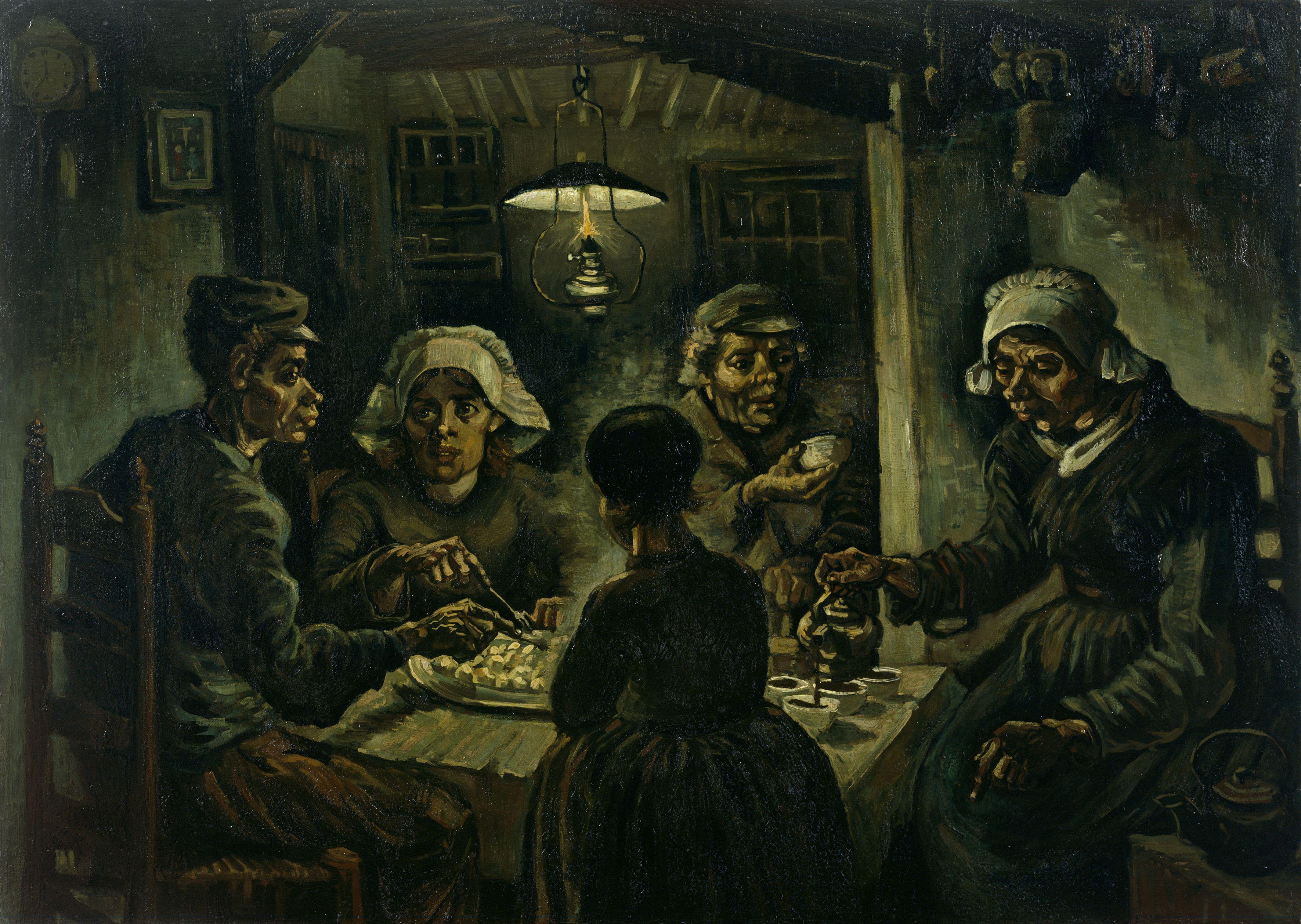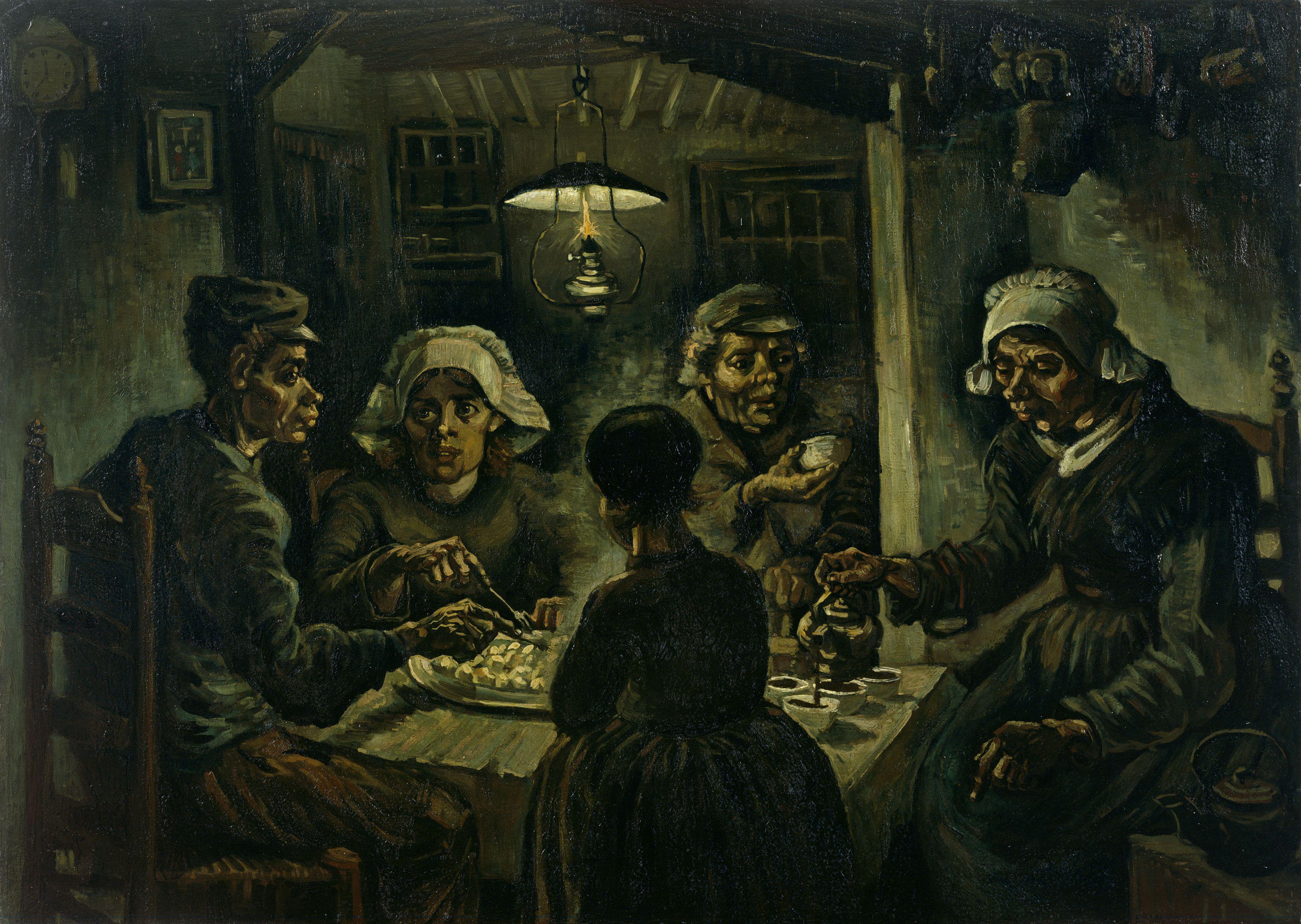
The piece of art that made me want to talk

Vincent Van Gogh's oil painting: 'the potato eaters', also known by its Dutch name 'De Aardappelters'. Painted in 1885 in Nuenen, Netherlands, one of the many accommodations for Van Gogh during his lifetime.
"Aardappel", the word for potato, translates literally to "Earth Apple" which perfectly reflects the worth of the potatoes to this family, it is their own fruit straight from the earth which they work with.
I first came across this painting on a trip to the Van Gogh museum in Amsterdam and had the great privilege of seeing it in person.
At first glance, among the array of paintings, landscapes and portraits surrounding me, all of Vincent's style, this was the first I had seen with multiple figures, multiple people with multiple back stories. This may have also been what attracted Van Gogh to his own idea of the piece, the connection of many different people, all living in pain or poverty, all with their own struggles and harsh realities. For much of his own life, Van Gogh suffered with depression and psychotic episodes, often affecting the moods and colours which may be portrayed in each of his thousands of works. He was seen almost as a madman during his life, ignored by many- just as these peasants would have been.
Van Gogh considered this his "showpiece", as he aspired to be a true "peasant painter" like the French painter Jean-François Millet and deliberately chose difficult composition to prove that he was on the way to becoming a well developed figure painter. Throughout his life, he had the emotional and financial support of his brother and friend, Theo, who was an art dealer in Paris. Theo was his biggest fan and critic in one, and after seeing The Potato Eaters, the piece Vincent thought of as some of his best work, Theo brought him to Paris... To improve.
At the forefront of this painting sit the peasants around a small table with their only light source being a dull lit oil lamp. The immediately noticeable aspect of the potato eaters is their ugly faces, the harsh, coarse lines, boney hands and grubby look to their appearance.
Vincent spent time studying the faces of peasants on the street and created separate "sketches" of their faces in order to compose what he called his "rough study", he intended on capturing the raw reality of life in poverty as he had previous strong connections with a homeless community during his time in 1879 in Belgium as a coal mining missionary. He sacrificed his comfortable lodgings at a bakery for a homeless person and went on to live in a small hut where he slept on straw, this resulted in his dismissal from church authorities for "undermining the dignity of the priesthood".
After being a part of this opposing lifestyle to his previous high class, Vincent must have gained a wider insight and interest into these lives of the poor, which encouraged him to paint them.
His vision when painting these figures in earth colours was to make their faces
"something like the colour of a really dusty potato, unpeeled of course".
The thing that draws me in about this painting, is Van Gogh's intriguing use of light variation. Upon closer inspection, you may notice a small clock in the top left hand corner on the wall, which reads 7 o'clock. Despite the black sky seen through the window, it is actually 7 in the morning, a winter morning. Of course, there is an overall atmosphere of melancholy darkness about this scene, however the small oil lamp manages to bring light to the faces of the peasants.
This could be Vincent's way of showing of their ugly looks. Or it could be to present their facial expressions, facial expressions not of sorrow, or pain, but of satisfaction, maybe thanks to eating their well earned breakfast.
This breakfast is also a point which is illuminated, as though it is a meal to be proud of. To others, this simple meal of potatoes and a warm beverage may not be our dream delicacy, but to these hard working people, who make their own food and plough their own fields, it is their daily reward.
However, the illumination that I am most interested in, is the halo of light surrounding the head of the centre figure who's back is shielding the viewers from seeing her face and identity. The father figure on the left seems to be looking at this figure, who resembles a young woman. However, this young woman is not wearing the same bonnet as the other two female figures depicted in the scenery. This makes me wonder whether she is someone who doesn't really belong there, or maybe they couldn't afford to make another bonnet style cap for her.
This sparks my questions of..
Who is she?
Why can't we see her face?
Is she significant, or rather the opposite?
And why does she not wear a bonnet like the two other female figures?
This girl seems to be the centre point, bringing balance and symmetry to the piece, yet we can't see her or who she is meant to be.
Van Gogh was believed to have several unsuccessful romances and unrequited loves, one of which 'Gordina de Groot' is a potato eater herself.
Could this unknown figure in the middle be his dreamed future wife and love?
With regards to their potato meal, Vincent wanted to depict the reality of manual labour. That these peasants have "tilled the earth themselves with these hands they are putting in the dish" which puts greater value upon these simple potatoes which they so deserve to eat. Vincent may have experienced this value of food firsthand when working with the minors and wanted to recreate that special satisfaction within this painting.
As we know, Vincent has been in touch with religion through his life and may have been linking that to this piece. He strongly admired the work of Charles de Groux, in particular, his work "The blessing before supper" which closely links the the famous "last supper".
Also, next to the clock in the corner, there is a framed picture or painting which seems to resemble two figures and a cross, one figure in blue, and one in red. This could be symbolic of his religious attitudes and makes me wonder whether the halo of light is a reflection of this as well.
Van Gogh sent Theo a sketch of the potato eaters, and that was when Theo invited him to Paris because he believed the painting would not be well-received in the French capital, where Impressionism had become the trend. The Potato Eaters was also criticised by his friend Anthony Van Rappard soon after it was painted, which caused a knock the Vincent's confidence.
Throughout his life, Vincent Van Gogh was seen by many to be a failure and a lunatic, it wasn't until after his death that an interest begun to circle around his works, particularly the potato eaters.
Within this piece, I find that there is so much to look at, and so much to question. In some ways I want to dive into their world and listen to what they are talking about. Or are they even talking? In other ways I enjoy admiring it from my own perspective, from a point of view where I can sit and ponder in the mystery of what it was really like, for Vincent and the subjects in his painting.
- As some may know, I used this speech to compete in the ARTiculation prize 2019 and amazingly recieved 2nd place in my regional's final. I am very proud of this accomplishment, not only for the outcome, but also because of the courage, effort and passion that I put in to get there.